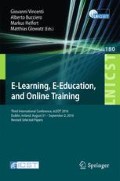Abstract
This paper describes the introduction of the use of physical artefacts in the teaching of the undergraduate curriculum in the Department of Computer Science at Middlesex University. The rationale for the change is discussed, together with a description of the various technologies and the areas in which they were deployed. We conclude with a discussion of the outcomes of the work and the conclusions reached, prime amongst which are that the policy has been successful in motivating and engaging students, with a resultant improvement in student progression.
Access this chapter
Tax calculation will be finalised at checkout
Purchases are for personal use only
References
Ahadi, A., Lister, R., Teague, D.: Falling behind early and staying behind when learning to program. In: Proceedings of the 25th Psychology of Programming Conference, PPIG (2014)
Blikstein, P.: Gears of our childhood: constructionist toolkits, robotics, and physical computing, past and future. In: Proceedings of the 12th International Conference on Interaction Design and Children, pp. 173–182. ACM (2013)
Buechley, L., Eisenberg, M., Catchen, J., Crockett, A.: The LilyPad Arduino: using computational textiles to investigate engagement, aesthetics, and diversity in computer science education. In: Proceedings of the SIGCHI Conference on Human Factors in Computing Systems, pp. 423–432. ACM (2008)
Cambron, M.E.: Using the Ardunio in freshmen design. In: Sixth Annual (FYEE) First Year Engineering Experience Conference on Enhancing the First Year of Engineering Education College Station, TX, 7–8 August 2014
Herger, L.M., Bodarky, M.: Engaging students with open source technologies and Arduino. In: 2015 IEEE Integrated STEM Education Conference (ISEC), pp. 27–32. IEEE (2015)
Kato, Y.: Splish: a visual programming environment for Arduino to accelerate physical computing experiences, pp. 3–10. IEEE (2010). doi:10.1109/C5.2010.20
Okita, S.Y.: The relative merits of transparency: investigating situations that support the use of robotics in developing student learning adaptability across virtual and physical computing platforms: relative merits of transparency in learning adaptability. Br. J. Educ. Technol. 45, 844–862 (2014). doi:10.1111/bjet.12101
Robins, A.: Learning edge momentum: a new account of outcomes in CS1. Comput. Sci. Educ. 20, 37–71 (2010). doi:10.1080/08993401003612167
Rubio, M.A., Romero-Zaliz, R., Mañoso, C., de Madrid, A.P.: Enhancing an introductory programming course with physical computing modules. In: 2014 IEEE Frontiers in Education Conference (FIE), pp. 1–8. IEEE (2014)
Boender, J., Currie, E., Loomes, M., Primiero, G., Raimondi, F.: Teaching functional patterns through robotic applications. In: Proceedings TFPIE 2015: The Fourth International Workshop on Trends in Functional Programming in Education (2015)
Racket Asip Client Library. https://github.com/fraimondi/racket-asip
The MIddlesex Robotic plaTfOrm (MIRTO). https://github.com/fraimondi/myrtle
Creative Robotics: HUB-ee, About-HUBee-Wheels. http://www.creative-robotics.com/
Clarkson, R.: A Self Contained Arduino Toolbox, Middlesex University Undergraduate Project submitted, 24 April 2014
Author information
Authors and Affiliations
Corresponding author
Editor information
Editors and Affiliations
Rights and permissions
Copyright information
© 2017 ICST Institute for Computer Sciences, Social Informatics and Telecommunications Engineering
About this paper
Cite this paper
Currie, E., James-Reynolds, C. (2017). The Use of Physical Artefacts in Undergraduate Computer Science Teaching. In: Vincenti, G., Bucciero, A., Helfert, M., Glowatz, M. (eds) E-Learning, E-Education, and Online Training. Lecture Notes of the Institute for Computer Sciences, Social Informatics and Telecommunications Engineering, vol 180. Springer, Cham. https://doi.org/10.1007/978-3-319-49625-2_15
Download citation
DOI: https://doi.org/10.1007/978-3-319-49625-2_15
Published:
Publisher Name: Springer, Cham
Print ISBN: 978-3-319-49624-5
Online ISBN: 978-3-319-49625-2
eBook Packages: Computer ScienceComputer Science (R0)

